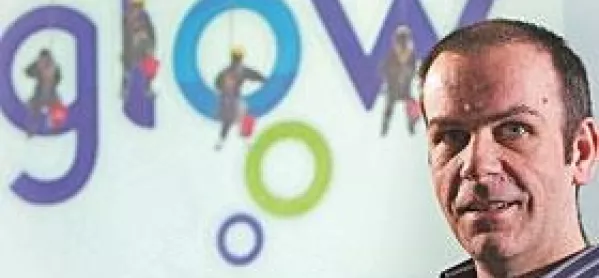New vision converts former RE teacher

The Kaaba, which all Muslims face when they pray, is in the central courtyard of the Grand Mosque in Mecca. According to tradition, it is a replica of God’s house in heaven.
A line drawing in a textbook that has been thumbed by countless teenagers is unlikely, therefore, to do it justice. And it was when faced with such an unsatisfactory means of communicating the mosque’s true splendour that Andrew Brown, now head of Glow, but a former RE teacher, realised computers had a major role to play in education.
Not only could he show the mosque in all its glory using new technology, but he could explain better exactly where in the world it was. Today, he could fly pupils from Scotland to Saudi Arabia using Google Earth, he points out.
That was Mr Brown’s epiphany, and it marked the beginning of his journey from classroom teacher at Helensburgh’s Hermitage Academy, to where he finds himself today: head of Glow and holed up in a meeting room at Learning and Teaching Scotland’s headquarters, speaking to The TESS, following a splurge of negative comments about the schools’ intranet.
Mr Brown entered teaching because he saw religious education as a vital subject but one that was often marginalised or poorly delivered. He wanted to use the subject to “help young people find their place in the world”. Seeing the potential of technology to transform teaching set him on a different path, however, and in November he was appointed head of Glow.
In his new post, he has had something of a baptism of fire. His blog makes it clear he knew from the outset all was not well. As a Glow development officer, he admits, he failed to make the impact he had hoped. As head, he could get “stuck into the challenge of making Glow better”, he wrote.
Last month, an early advocate and pioneer of Glow, Jaye Richards, attacked it, calling it “clunky” and “not user-friendly” (TESS, January 8). Since then, in chatrooms and on blogs, a spate of overwhelmingly negative critiques have followed.
Glow will undergo a lot of change this year, says Mr Brown, but he refuses to accept things are as bad as Scotland’s so-called “edu-technorati” would have us believe.
“If people are saying it’s difficult to use, then let’s make the changes - but let’s set this in context. There are hundreds of classrooms at the moment making great use of it, sharing news and documents, collaborating online and moving away from traditional methodologies.”
A major criticism is that web 2.0 tools like blogs and wikis are not available. But they will be this year, and Glow will bring them to far more teachers, says Mr Brown.
“I suspect, although I’ve never researched this, that it’s between 1 to 5 per cent of the teaching population in Scotland who are using web 2.0 technology in their teaching - there are already more than that using Glow. What I’d love to do now is introduce them to the web 2.0 world of sharing - Glow will facilitate that this year.”
The schools’ intranet is a safe and secure platform on which teachers unused to new technology can cut their teeth, he adds. Its “complicated” discussion forums are also set to be updated in line with user demands, and sharing among teachers is about to become a lot easier, he continues. Teachers will soon be able to search for resources across Glow and make their own work available to every other teacher in Scotland.
Some might argue this was what Glow was meant to do from day one, but sometimes you have to get where you are going by degrees, says Mr Brown. “If we had put that in on day one, I suspect local authorities would have been nervous, because what you are saying is you expect everyone to share everything immediately. It was not LTS’s place to suggest that.
“But now people are coming back to Glow and, overwhelmingly, they want to see an increase in sharing take place.”
If Glow can encourage teachers to share what they are doing, that will be hugely significant, Mr Brown believes. “Teachers are good at recognising great resources, but what they are not very good at doing is sharing as well as they possibly could. The biggest challenge in Scottish education is not Glow or the development of Curriculum for Excellence; it’s convincing teachers it’s a good thing to share. Glow makes it easy to do that.”
There are things, however, outwith Mr Brown’s control that could have a “massive impact” on the intranet’s success, he admits. The first is bandwidth. If schools have poor internet connectivity, they will not use Glow, he says. “If you are wasting time waiting for things to load because of technical issues, you’re not going to use it, regardless of the quality of the resource.”
Another is the number of computers available in schools. Are there enough to make Glow integral to learning? “If our goal is to roll this out to all teachers, parents and pupils, how many devices are out there?” he asks.
Keep reading for just £1 per month
You've reached your limit of free articles this month. Subscribe for £1 per month for three months and get:
- Unlimited access to all Tes magazine content
- Exclusive subscriber-only stories
- Award-winning email newsletters



